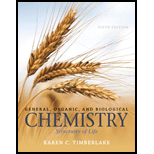
Concept explainers
Interpretation:
“The volume of the chamber containing ” should be calculated
Concept Introduction:
Here we have used the concept of ideal gases and its equation.
► Ideal gases are the gases which obeys the ideal gas equation under all conditions of temperature and pressure. The ideal gas equation can be obtained by combining the Boyle’s Law, Charles’s
► Boyle’s Law: It states that at constant temperature, the pressure has an inverse relation with volume
► Charles’s Law: It states that at constant pressure, the volume of the gas has direct relation with temperature
► Avogadro Law: It states that equal volumes of all gases under same conditions of temperature and pressure contains the same number of molecules
Volume of the gas Number of molecules
Moles of the gas
► Combining these three laws, we get the ideal gas equation
where,
is universal gas constant
is the volume
is the number of moles
is the pressure
is the temperature
► The relation between number of moles and mass of the gas is
Where is the mass of the gas
is molar mass of the gaseous compound
► Molar mass is the number of times a molecule of the substance is heavier than the mass of an atom of carbon .
Given:
Mass of
Pressure inside a hyperbaric chamber,
Temperature of the chamber,
Want to see the full answer?
Check out a sample textbook solution
Chapter 8 Solutions
General, Organic, and Biological Chemistry: Structures of Life (5th Edition)
 ChemistryChemistryISBN:9781305957404Author:Steven S. Zumdahl, Susan A. Zumdahl, Donald J. DeCostePublisher:Cengage Learning
ChemistryChemistryISBN:9781305957404Author:Steven S. Zumdahl, Susan A. Zumdahl, Donald J. DeCostePublisher:Cengage Learning ChemistryChemistryISBN:9781259911156Author:Raymond Chang Dr., Jason Overby ProfessorPublisher:McGraw-Hill Education
ChemistryChemistryISBN:9781259911156Author:Raymond Chang Dr., Jason Overby ProfessorPublisher:McGraw-Hill Education Principles of Instrumental AnalysisChemistryISBN:9781305577213Author:Douglas A. Skoog, F. James Holler, Stanley R. CrouchPublisher:Cengage Learning
Principles of Instrumental AnalysisChemistryISBN:9781305577213Author:Douglas A. Skoog, F. James Holler, Stanley R. CrouchPublisher:Cengage Learning Organic ChemistryChemistryISBN:9780078021558Author:Janice Gorzynski Smith Dr.Publisher:McGraw-Hill Education
Organic ChemistryChemistryISBN:9780078021558Author:Janice Gorzynski Smith Dr.Publisher:McGraw-Hill Education Chemistry: Principles and ReactionsChemistryISBN:9781305079373Author:William L. Masterton, Cecile N. HurleyPublisher:Cengage Learning
Chemistry: Principles and ReactionsChemistryISBN:9781305079373Author:William L. Masterton, Cecile N. HurleyPublisher:Cengage Learning Elementary Principles of Chemical Processes, Bind...ChemistryISBN:9781118431221Author:Richard M. Felder, Ronald W. Rousseau, Lisa G. BullardPublisher:WILEY
Elementary Principles of Chemical Processes, Bind...ChemistryISBN:9781118431221Author:Richard M. Felder, Ronald W. Rousseau, Lisa G. BullardPublisher:WILEY





